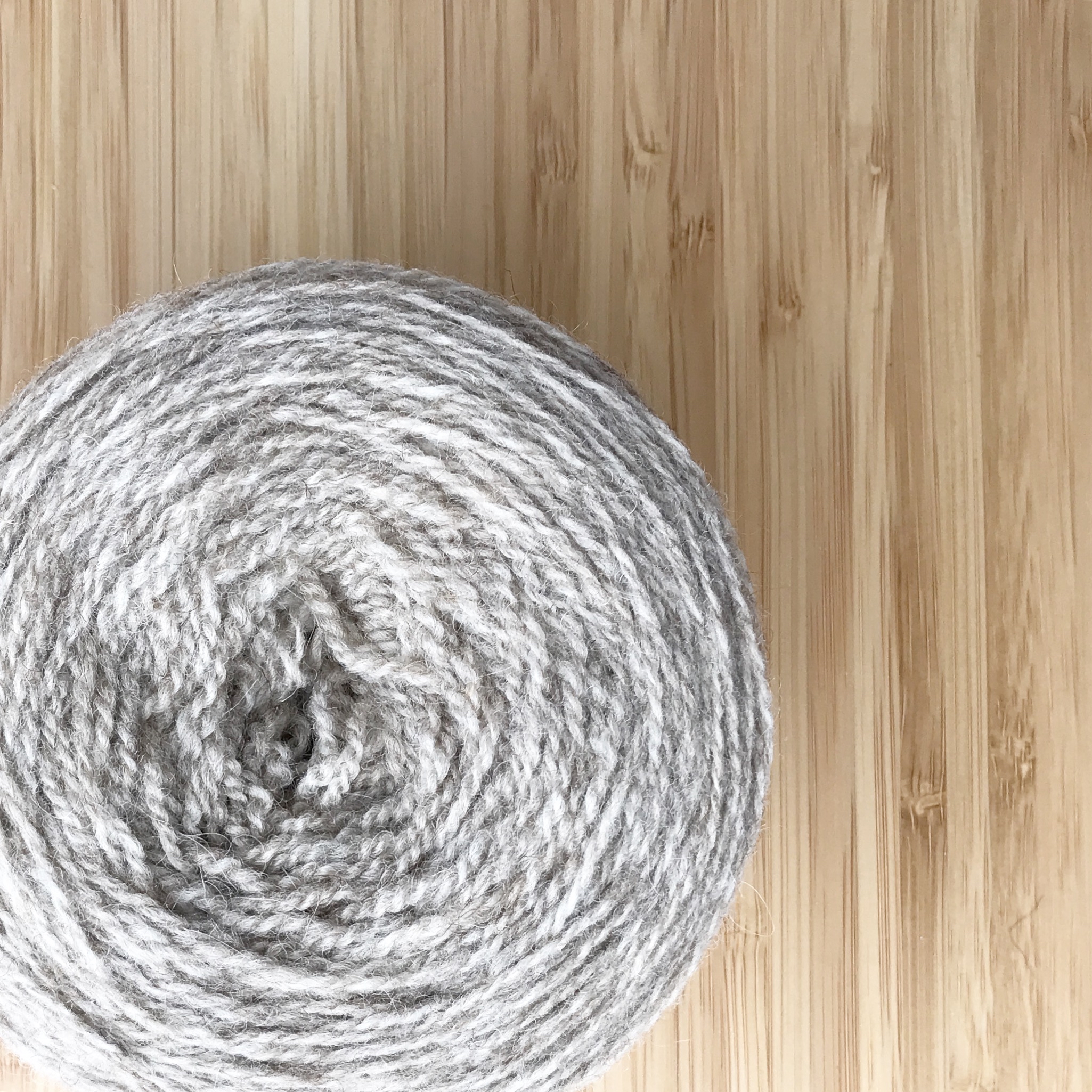The organic wool company Garthenor was born in the 1990s on the King family farm in the Cambrian Mountains of Mid Wales. In the early days Sally King spun the wool herself from the family’s own Ryeland, Shetland, Herdwick and Manx Loaghtan sheep - that is, until demand for their certified organic and undyed yarn began to outstrip supply. Now the Kings supplement their own production with raw fleeces they source directly from farmers across the UK, and their yarn is sold across the UK. This means you can draw a direct line from the wool on your needles to the sheep in the paddock.
The farm already had organic certification, so the family worked with the Soil Association to establish an organic textile standard to include wool - standards that were finalised in 2003 when Garthenor Organic Pure Wool became the first fully certified organic yarn in the world.
We are so happy to be able to bring these lovely yarns into New Zealand, and we think their philosophy - which you can see in full here - is perfectly aligned with our own. It includes principles such as “good work takes time,” “be your own customer,” and “environmental responsibility.” We couldn't agree more.
In addition to wool from laceweight to bulky, Garthenor offers a range of beautiful woolen socks made on World War I era knitting machines, yarn kits, and a bespoke knitting service that could see you have your own jumper handknit to your exact specifications.
Once you've laid hands on the yarn, what to make? Of course you could do anything - socks, jumpers, blankets, hats, mittens, maybe a tea cosy or two! Or you could give these a try: Garthenor is now stocking a shawl kit built around a pattern just released by Dutch knitting instructor and designer Puk Vossen. The Station Zwaan Shawl will work with two different weights (lace and four-plly) of Garthenor. If a sweater is more your thing, have a look at the Amory jumper designed in Garthenor laceweight by German designer Isabell Kraemer. Can’t decide? Knit both - and check out our range of Garthenor here.
To learn more about life at Garthenor, we caught up with Sally King and her son, Jonny, to talk organics, heritage breeds and what’s ahead for them.
Newtown House: Garthenor is a family operation - how did you and your family find your way to this lifestyle? Do you come from a history of farmers, shepherds, or the fibre trade? And who does what on the farm and in the shop?
Sally King: We moved here in 1994 from the Cotswolds, when Jonny was just a baby. Whilst I’m not from a farming background as such, my father managed a large farm in Cornwall as I was growing up, and my grandparents had a farm in South Dorset, which I loved to visit, so it wasn’t a total leap into the unknown. For the three children growing up here at Garthenor, they’ve had no choice but to be farmers when needed!
Jonny King: We all pitch in when necessary! I’m definitely more office based now, as well as going out to meet all our supplier farmers throughout the shearing season. Sally and I work full time in the wool shed, and everything else seems to sort of fit in around it - which can get a bit hectic. Then of course Bob the sheepdog goes everywhere with us - she’s the boss!
NH: We're so impressed by the approach you have taken to fibre production. Can you tell us why is it important for you to have traceability from sheep to yarn and to have your organic certification? How hard is this to do in a competitive market?
JK: For us, it’s the way we’ve always done it. Since starting with wool from our own sheep, and then also buying fleece from other organic farmers, the relationship directly with the flock is of utmost importance, both for transparency and traceability, but also for quality. By working directly with the farmers, we’re able to give feedback on the fibre, and they can make small changes to their wool production for the next year. It certainly presents its own challenges in all aspects, but I think the final yarns speak for themselves.
SK: It was a big step for me when I first looked to buy in fleece from other farms, some 15 years ago now. To take the step from total control to having to trust other farmers to start the chain felt massive. Because of this, I’ve always been passionate that even as we grow, add new products and patterns, the fibre - and its origin - is at the heart of Garthenor.
NH: Have you noticed increased interest in heritage breeds of sheep? Why do you believe it's important to nurture and support farmers who are raising these breeds?
SK: In Britain especially, the multitude of sheep breeds that we have form part of our landscape. They’re each specialised to their own environments, and thrive in their native locations. I think some farmers are starting to appreciate this again, which is amazing for the diversity of farming around the country. So many knitters and crafters are also becoming more aware of the special qualities of each of the different types of wool, which is certainly a boost to the industry.
Who wouldn't fall in line with Bob?!
NH: And what's your favourite fibre?
SK: Shetland! We’ve had our own flock here for some 20 years, and the feeling of pulling on a woolly hat or a warm jumper from your own sheep is unbeatable.
Jonny: I’d definitely agree - all my socks are Shetland!
NH: Can you give us an idea of a "typical" week at the farm? What's your busiest time of year?
JK: Mondays generally start with shipping out orders we’ve had in over the weekend, and then taking a look at what’s happening on the farm and in the office. Then throughout the week, I’m mostly in the office or out on the road - getting around all our suppliers across the country is no mean feat!
SK: At this time of year on the farm, the sheep are fairly low maintenance - the rams are in, so it’s just a case of a morning walk around the fields to see that they’re all well. We use winter as a time to get lots of repairs and renovations done around the farm, like fencing and hedge laying. Lambing is definitely the busiest time of the year, but easily the most rewarding. All the hard work throughout the year culminates in new lambs bouncing around the field on sunny spring mornings - it reminds me exactly why I love this life.
Amory, a jumper designed by Isabell Kraemer in Garthenor's Shetland laceweight yarn.
NH: What trends are you seeing in the wool industry at the moment? Are efforts like the Campaign for Wool helping to boost interest in wool and the sustainability of this fabulous fibre?
JK: The wool industry is definitely shifting towards more traceability, and more appreciation of origin, rather than just the finished product. We’ve definitely noticed more awareness of fibres of all types - it contributes to the enjoyment of slow fashion.
SK: We also work closely with the British Wool Marketing Board, who are passionate about proving the worth of all the different grades of British wool - from the crunchy and crispy Herdwick to the soft and silky Shetlands.
NH: What's ahead for Garthenor?
SK: Ronas, our newest special edition yarn, has just launched online, so we’re excited to see the direction that takes. It’s a Shetland yarn produced exclusively with wool from the Shetland Isles, and spun in Scotland - we worked with Uradale Yarns to produce it.
JK: We’ve also got a few new yarns coming out over the next couple of months - and a huge announcement coming towards the end of the year. Stay tuned!
NH: Finally what's on the needles at Garthenor ... and are there any patterns out there you'd highlight at the moment? (Along with Amory of course!)
JK: Socks, socks and more socks! I love working with antique circular sock knitting machines, so you can guess what everyone gets for Christmas!
SK: Puk Vossen has just designed a beautiful shawl, the Station Zwaan Shawl, which went straight onto my needles - the lace and four ply versions (I couldn’t decide which to go for!).
All photos courtesy Garthenor





